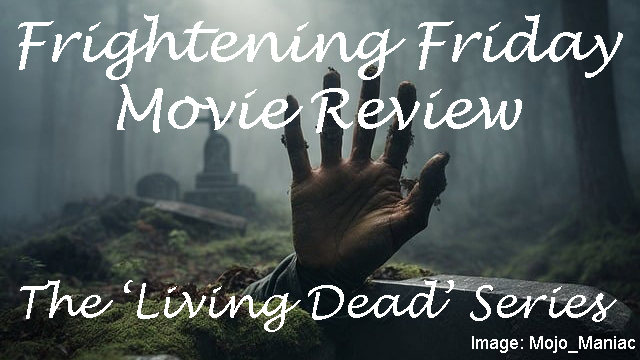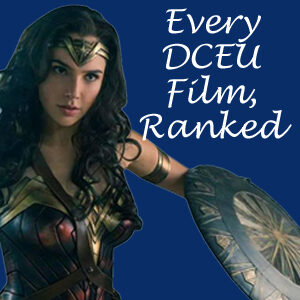“Night of the Living Dead” (1968) popularized zombie fiction, but writer-director George A. Romero went a decade before delivering the sequel, “Dawn of the Dead” (1978). He wanted to avoid stereotyping himself as a zombie-film director. Woops, that didn’t work out.
As with the first one, a modern viewer is faced with the decision of whether to judge this in historical context, or as we’d judge any other film. “Dawn of the Dead” is a landmark piece of cinema, as we see early Tom Savini practical effects; co-producer Dario Argento brings his giallo stylings over from Italy (he’s also the editor on the European release, titled “Zombi”); and we get a time capsule of shopping malls.
As a piece of entertainment, “Dawn” is overlong (various cuts exist, but all are over 2 hours), as slow-moving in plot as the zombies are in walking pace. Savini’s effects in the heroes’ final showdown with the biker gang are impressive – including zombies chowing down on strings of intestines – but in general the zombies look like Pennsylvania citizens with their faces painted blue. The first time a zombie takes a bite out of a human, it looks like her shoulder is made out of cake.

“Dawn of the Dead” (1978)
Director: George A. Romero
Writer: George A. Romero
Stars: David Emge, Ken Foree, Scott H. Reiniger
The action choreography is better than “Living Dead’s,” but not by much. Every time a hero strikes a zombie, we can tell they are cautiously striking an extra. Or else it’s an isolated effects shot with that ketchup-like Seventies movie blood (also prominent in another post-apocalyptic actioner, 1971’s “Escape from the Planet of the Apes”).
If I didn’t know “Dawn” was directed by Romero, I’d have guessed John Carpenter, who broke through this same year with the tighter and scarier “Halloween.” Carpenter does settings better – I think of the evocative “Escape from the New York” (1981) – but he and Romero have the same notions of alpha males (and one alpha female here) fighting monsters and nasty humans amid a decaying society.
Going shopping in the apocalypse
“Dawn” is often called a satire of consumerism, and strictly speaking, it is. But boy does that phrase promise more than the film delivers. It’s at its most satirical when main hero Peter (Ken Foree) notes that the zombies are drawn to the mall not because he and three other humans are inside, but rather because of their residual memories of the mall as a place they wanted to visit.

And that’s about it for the satire. “Dawn” is actually a celebration of indoor shopping centers, both in 1978 when they were novel, and when viewed today – when a lot of viewers miss malls.
Everyman Peter and his three fellow survivors – police trooper Roger (Scott Reiniger), helicopter pilot Stephen (David Emgee), and Stephen’s headstrong girlfriend Fran (Gaylen Ross), a TV news producer – are rightfully pleased to have found this mall (almost an hour into the film!). And luckily, it’s one that contains a grocery store, a hardware store and a guns-and-ammo store.
Logistics and planning in a zombie dystopia
They can hole up here for a long time until their supplies run out, or until a better option comes along. That’s the weird thing about “Dawn” when watched by someone more familiar with the perpetual tension of “The Walking Dead”: This is mostly a calm logistics piece.
The quartet strategically and methodically clears the mall of zombies, and sets themselves up in a secure upstairs area by hiding the stairwell entrance. When they say the zombies can’t get through the glass doors because they can’t get leverage (Peter and company have parked semi-trucks parallel to the doors), they are absolutely correct. They truly are safe here (from the undead).
“Dawn” is unconcerned with its lack of tension. Indeed, the music – from Argento and his band – is upbeat, playful and even comedic as we see montages of the quartet doing their hard but satisfying work.
When the bikers barge in, their slaughter of zombies is more violent, but still more like a game than a war. We’re even made to feel sorry for the zombies, because they’re dispatched gleefully rather than dutifully. And Romero awkwardly tries a gag once, as a severed arm in a blood-pressure cuff sets off a warning bell.
Decaying trust in TV news
While the mass-consumerism satire isn’t as sharp as you might expect, “Dawn” does better at making fun of punditry and noise in TV news media – a notable contrast to the Cronkite-era information and instructions found in “Living Dead.”
We begin in the TV studio where Fran works. Someone mentions that the list of shelters scrolling on the screen has been inaccurate for hours. The boss screams to keep the inaccurate list scrolling, otherwise people will tune out.
When our quartet later watches the news channel, a science expert explains the reality of the pandemic and the fact that zombies must be killed – even though they may look like your loved one. People in the TV studio scream and curse at the scientist for being logical and emotionless.
“Dawn” is much more of a commentary on the idiocy creeping into TV news – and the people who consume it – than it is a critique of people who enjoy shopping in a convenient single location. If anything, it’s a love letter to malls. But this was before the mall culture of the next two decades, so it doesn’t have a significant mall flavor with stereotypes and caricatures. It’s simply a big building with robust supplies.
Overall, “Dawn of the Dead” isn’t tight enough to be firmly defined as anything particularly striking. It’s a simple story of four survivors, Romero’s randomly selected focal point amid the survival epic that’s happening in the world beyond Pittsburgh. It’s undeniably an important film in zombie fiction – hinting at grander possibilities than the 1968 original – but I find it to be overpraised.

